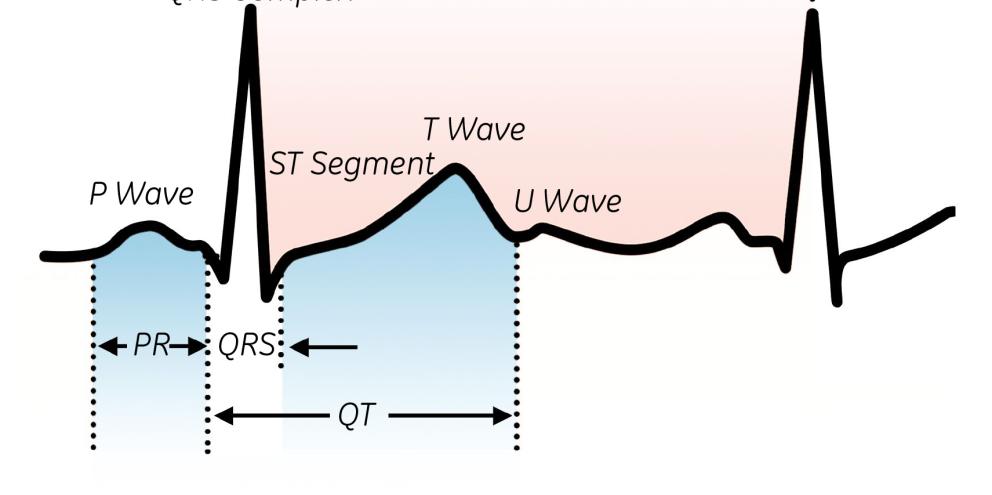Professor Dr. med. Patrick Friederich
Background
The Long QT syndrome (LQTS) is characterized by prolongation of the QT interval in the electrocardiogram and polymorphic ventricular tachycardia known as Torsades de pointes (TdP). see Figure 1. LQTS can either be inherited or acquired, with both forms leading to altered ion channel function and impaired repolarization of ventricular action potentials.¹ The prevalence of congenital LQTS may be as high as 1/2000, with LQT1 and LQT2 being the most frequent subtypes comprising nearly 90 percent of genotyped LQTS patients.² Both LQT1 and LQT2 result from mutations in cardiac potassium channels. These channels are called Kv7.1 and human ether-à-go-go-related gene (HERG) or Kv11.1 potassium channels.¹
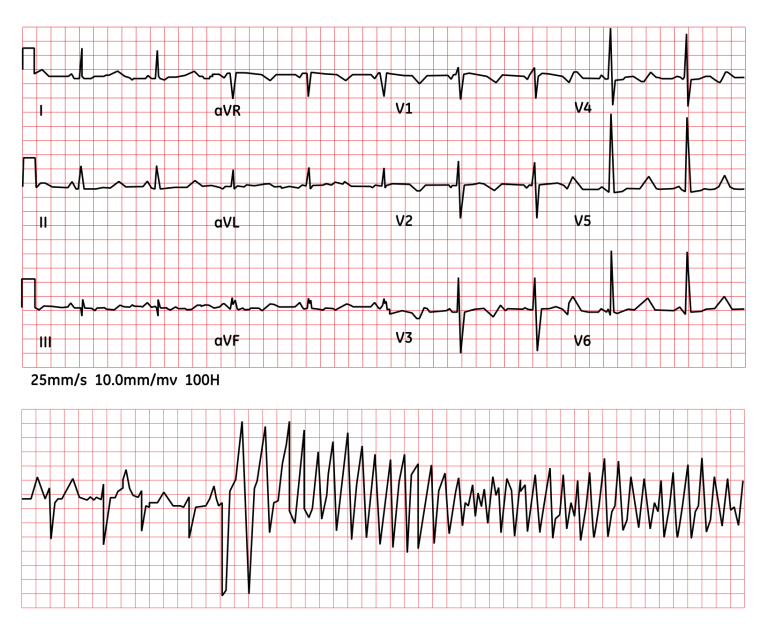
Acquired LQTS is typically caused by interaction between a wide variety of drugs with HERG potassium channels.³ These drugs include several that are frequently used in perioperative and critical care, such as volatile anesthetics, antibiotics, antiemetics as well as antipsychotic agents. Acquired LQTS is likely to be even more common than the inherited forms. Acquired LQTS may aggravate inherited LQTS, and both forms may be aggravated by structural heart disease, hypothermia, electrolyte disorders and cardiac ischemia.¹ ⁴ ⁵ The overall incidence of acquired and inherited LQTS will, therefore, be significantly higher than the incidence of, for example, malignant hyperthermia, cystic fibrosis or multiple sclerosis.
During perioperative and critical care treatment, patients with acquired or inherited LQTS may be at an increased risk of developing malignant cardiac arrhythmia such as R on T phenomena and TdP.⁶ ⁷ TdP may lead to syncope and sudden cardiac death. Several risk factors for the induction of TdP exist with many of those relevant in perioperative and critical care. see Figure 2. Although patients with LQTS are often equipped with an internal cardioverter defibrillator (ICD) for immediate treatment of TdP, these devices frequently need to be switched off during operations. The perioperative management of patients suffering from LQTS is challenging, and a need for standardized treatment has been recognized.⁷ The administration of several drugs to patients suffering from congenital LQTS, including droperidol, requires monitoring of the QT interval. Monitoring of the QT interval during the entire perioperative treatment of patients with LQTS, thus, forms an integral part of current recommendations for standardized treatment.⁷
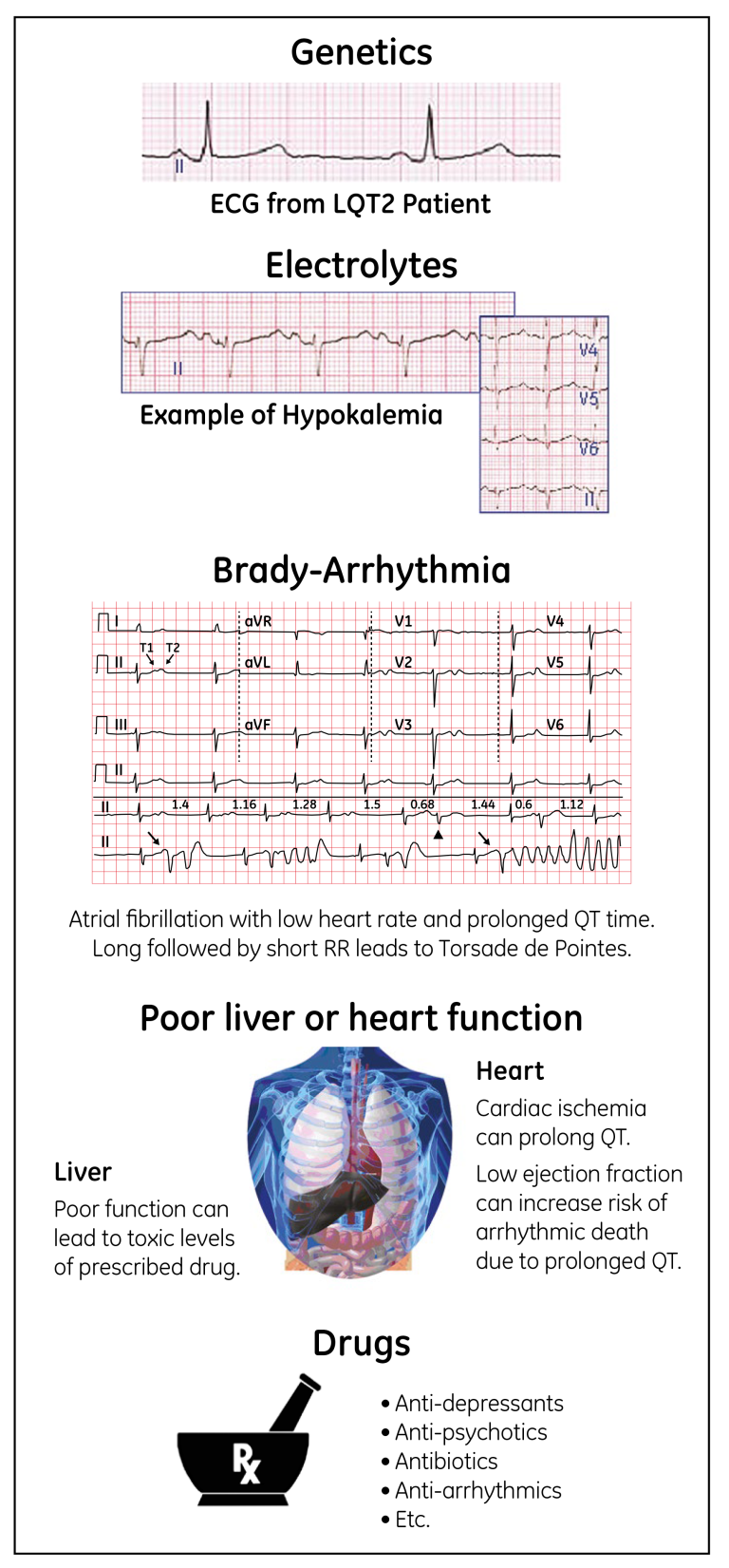
Determination of the QT interval
The QT interval represents cardiac repolarization. It is measured from the beginning of the Q wave to the end of the T wave.⁸ ⁹ see Figure 3. The length of the QT interval is influenced by the heart rate. In order to categorize a QT interval as normal or prolonged it is necessary to correct the QT interval for the heart rate. A QT value corrected for heart rate is named the QTc value. The QTc value is compared to a predicted reference QT value at a heart rate of 60 beats per minute.
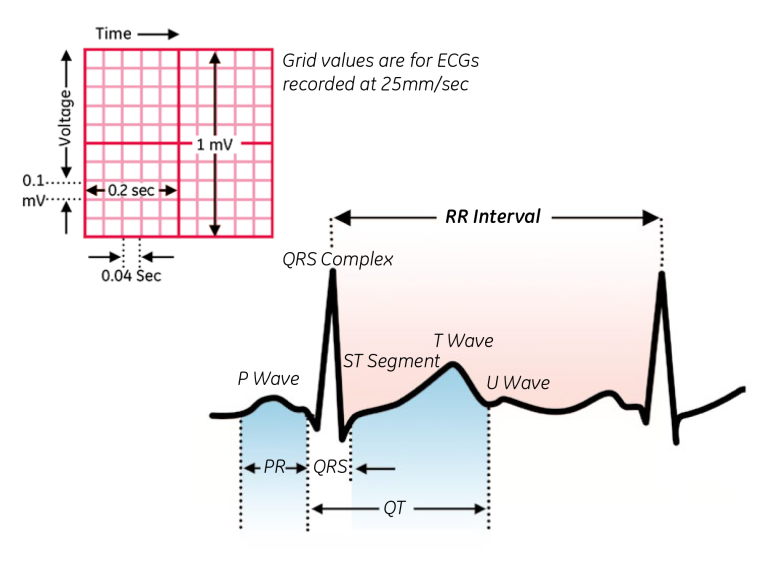
A widely used formula for correcting QT values for the heart rate was introduced by Henry Cuthbert Bazett in 1920.¹⁰ The Bazett formula still remains the standard for clinical use.⁸ ⁹ This formula states that the QT interval corrected for heart rate equals the duration of the QT interval divided by the square root of the duration of the preceding RR interval. see Figure 4.

In order to identify patients at risk of developing malignant cardiac arrhythmias normal values of QT interval duration have been suggested.¹ ⁸ ⁹ see Figure 5. They are age and gender dependent. Upper limits of normal lie between 450 ms in male adults, 450-460 ms in children and adolescents and 460-470 ms in female adults.¹ ⁸ ⁹ However, it should be recognized that some overlap exists between healthy subjects and individuals suffering from the LQTS.¹¹ Prolongation of the QT interval to durations of 500 ms and longer are most likely pathological. They mandate referral to Long QT specialists and may be followed by pharmacological interventions such as application of ß-blockers or implantation of an ICD.¹ ⁵
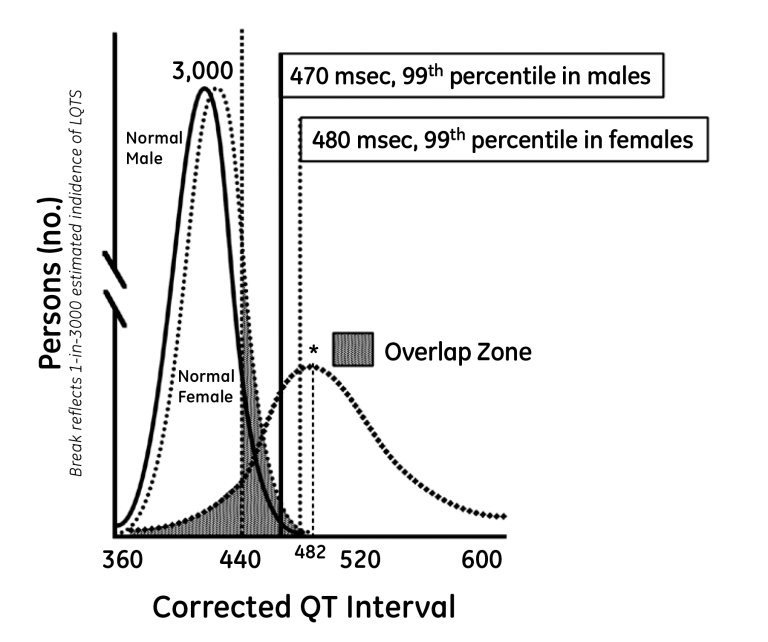
As pointed out above, calculating the duration of QTc interval requires measurement of the QT interval and correction for the heart rate. However, accurate manual determination of the QT interval, even in high resolution ECG printouts, seems difficult.¹¹ ¹² A study with physicians from different specialties revealed that correct classification of QT intervals was achieved by less than 25 percent of cardiologists and non-cardiologists alike, with only cardiology QT experts scoring above 95 percent.¹² While identification of the Q wave or the earliest onset of the QRS complex is simple, the most important obstacle to correct measurements of the QT interval constitutes the precise determination of the end of the T wave. Although the intercept of the descending limb of the T wave with the isoelectric line is considered the end of the T wave, this interception is often difficult to be identified by eye. see Figure 6. Even in the best case the accuracy levels of manual determination of QT intervals will be 20 to 40 ms.¹² High interobserver variability will, therefore, add to the 75 percent failure rate in not correctly determining the QT interval by non-QT specialists.

Apart from QT prolongation, TdP may be preceded by pathological changes in the ECG such as short-long-short RR intervals, T wave alternans, changes in T wave height, as well as R on T phenomena.¹ see Figure 7.

Determination of QT interval in Perioperative and Critical Care
Measurement of the QT interval in the operating theatre imposes additional challenges. Rather than being performed for diagnostic purposes alone, here the QT interval determination forms an integral part of patient monitoring. The aim of patient monitoring is not only to diagnose a pathological state, such as in the diagnostic ECG laboratory, but more frequently to detect changes earlier indicating transition from a normal to pathological heart rhythm in order to prevent such transitions occuring.
Manual measurement of the QT interval will be too time consuming for monitoring purposes, and it is unlikely to be feasible under the time constraints and the multitasking requirements of perioperative as well as critical care. It is, therefore, not surprising that manual measurements have so far only been validated under study conditions in postoperative surgical patients.¹³ Manual determination of the QT interval, although being important for diagnostic purposes, is thus unlikely to allow for repeated, as well as reliable, measurements of the QT interval necessary for monitoring purposes in the operating room or the critical care unit. Under these circumstances, automated determination of the QT interval needs to be considered as an alternative to manual measurements of the QT interval.
Two recent case reports demonstrate the feasibility of automatic determination of the QT interval in perioperative care.¹⁴ ¹⁵ The algorithm used in these patients uses a T wave detection function based on vector magnitude signals from eight independent lead (I, II, V1-V6) inputs.¹⁶ This algorithm does not require manual analysis of the QT interval, it is immediately available without interobserver variability and has been extensively validated in non-surgical populations. Although this algorithm is applicable in the operation room and the critical care unit, it requires 12-lead ECG recordings. As 12-lead ECG recordings are rarely used during monitoring of non-cardiac patients, reduced lead QT analysis requiring five electrodes has also been made available.
Patients suffering from both congenital as well as acquired Long QT syndrome, or being at risk of acquiring Long QT syndrome during drug treatment,¹⁷ may easily be monitored with automatic algorithms available for perioperative as well as critical care patients.¹⁴ ¹⁵ The introduction of reduced lead QT monitoring allows routine monitoring of QTc intervals in these patients. Based on current recommendation the application of continuous automatic monitoring of the QT interval constitutes an important improvement in patient monitoring and can help to increase the safety of patients suffering from, or being at risk of, developing LQTS during surgical operations or critical care treatment. The QT interval trend on the patient monitor as well as sophisticated arrhythmia alarms may improve detecting the impending risk of severe ventricular arrhythmia. Frequent visual inspection of the ECG displayed on the patient monitor for identification of short-long-short RR intervals, T wave alternans, changes in T wave height, as well as R on T phenomena will further add to the safety of treating perioperative and critical care patients suffering from LQTS.
About the author
Professor Dr. med. Patrick Friederich.
Chairman, Department of Anaesthesiology, Critical Care Medicine, Pain Therapy.
Klinikum Bogenhausen Academic Hospital of Technische Universität München.
References
- Morita, H. et al. The QT syndromes: long and short. Lancet 372,750-763 (2008).
- Schwartz, P.J. et al. Prevalence of the congenital long-QT syndrome. Circulation 120, 1761-7 (2009).
- Roden, D.M. Drug-induced prolongation of the QT interval. N Engl J Med 350, 1013-1022 (2004).
- Siebrands, C.C. et al. Long QT 1 mutation KCNQ1A344V increases local anesthetic sensitivity of the slowly activating delayed rectifier potassium current. Anesthesiology 105, 511-520 (2006).
- Vincent, G.M. et al. High efficacy of beta-blockers in long-QT syndrome type 1: contribution of noncompliance and QTprolonging drugs to the occurrence of beta-blocker treatment „failures“. Circulation 119, 215-21 (2009).
- Booker, P.D. and Whyte, S.D. Ladusans EJ. Long QT syndrome and anaesthesia. Br J Anaesth 90, 349-366 (2003).
- Kies, S.J. et al. Anesthesia for patients with congenital long QT syndrome. Anesthesiology 102, 204-210 (2005).
- Goldenberg, I. et al. QT interval: how to measure it and what is “normal“. J Cardiovasc Electrophysiol 17, 333-6 (2006).
- Rautaharju, P.M. et al. American Heart Association Electrocardiography and Arrhythmias Committee, Council on Clinical Cardiology; American College of Cardiology Foundation; Heart Rhythm Society. AHA/ACCF/HRS recommendations for the standardization and interpretation of the electrocardiogram: part IV: the ST segment, T and U waves, and the QT interval: a scientific statement from the American Heart Association Electrocardiography and Arrhythmias Committee, Council on Clinical Cardiology; the American College of Cardiology Foundation; and the Heart Rhythm Society: endorsed by the International Society for Computerized Electrocardiology. Circulation 119, 241-50 (2009).
- Bazett, H.C. An analysis of the time-relations of electrocardiograms. Heart 7, 353–370 (1920).
- Taggart, N.W. et al. Diagnostic miscues in congenital long-QT syndrome. Circulation 115, 2613-20 (2007).
- Viskin, S. et al. Inaccurate electrocardiographic interpretation of long QT: the majority of physicians cannot recognize a long QT when they see one. Heart Rhythm 2, 569-74 2005).
- Charbit, B. et al. QT interval measurement: evaluation of automatic QTc measurement and new simple method to calculate and interpret corrected QT interval. Anesthesiology 104, 255-260 (2006).
- Anton, D. and Friederich, P. Automated perioperative QT monitoring in a patient with long QT syndrome 2. Br J Anaesth 105, 701-2 (2010).
- Pfizenmayer, H. and Friederich, P. Perioperative monitoring of the QT interval. Anaesthesist 59, 633-5 (2010).
- Hnatkova, K. et al. Precision of QT interval measurement by advanced electrocardiographic equipment. Pacing Clin Electrophysiol 29, 1277-1284 (2006).
- Dolenska, S. Intraoperative cardiac arrest in acquired long QT syndrome. Br J Anaesth 102, 503-505 (2009).
ADDITIONAL RESOURCES
For white papers, guides and other instructive materials about GE Healthcare’s clinical measurements, technologies and applications, please visit http://clinicalview.gehealthcare.com

